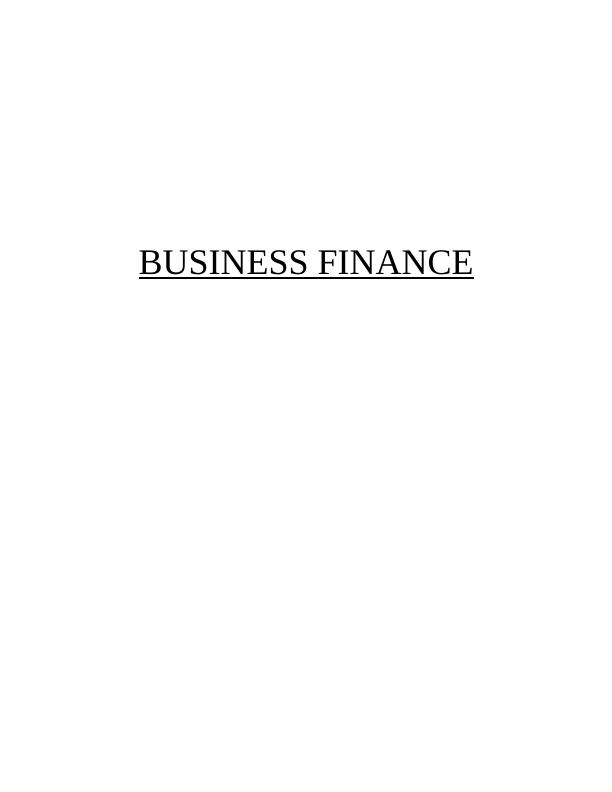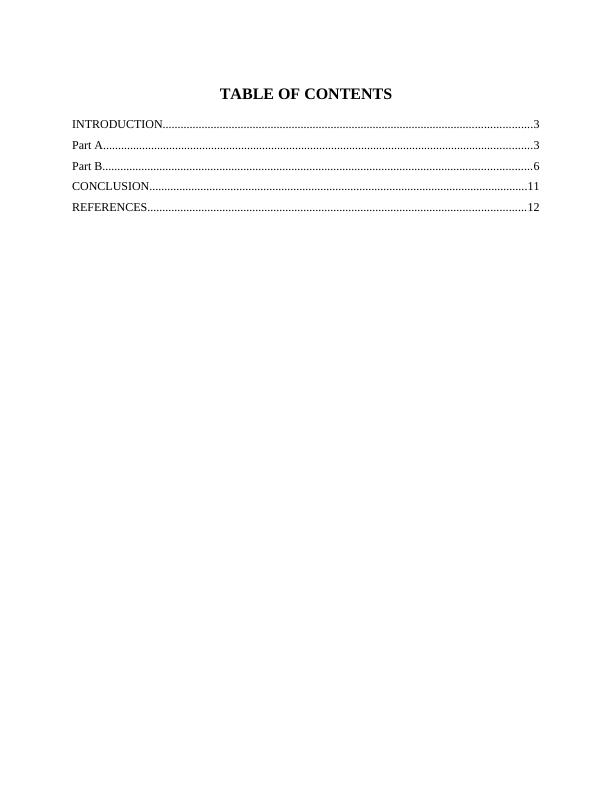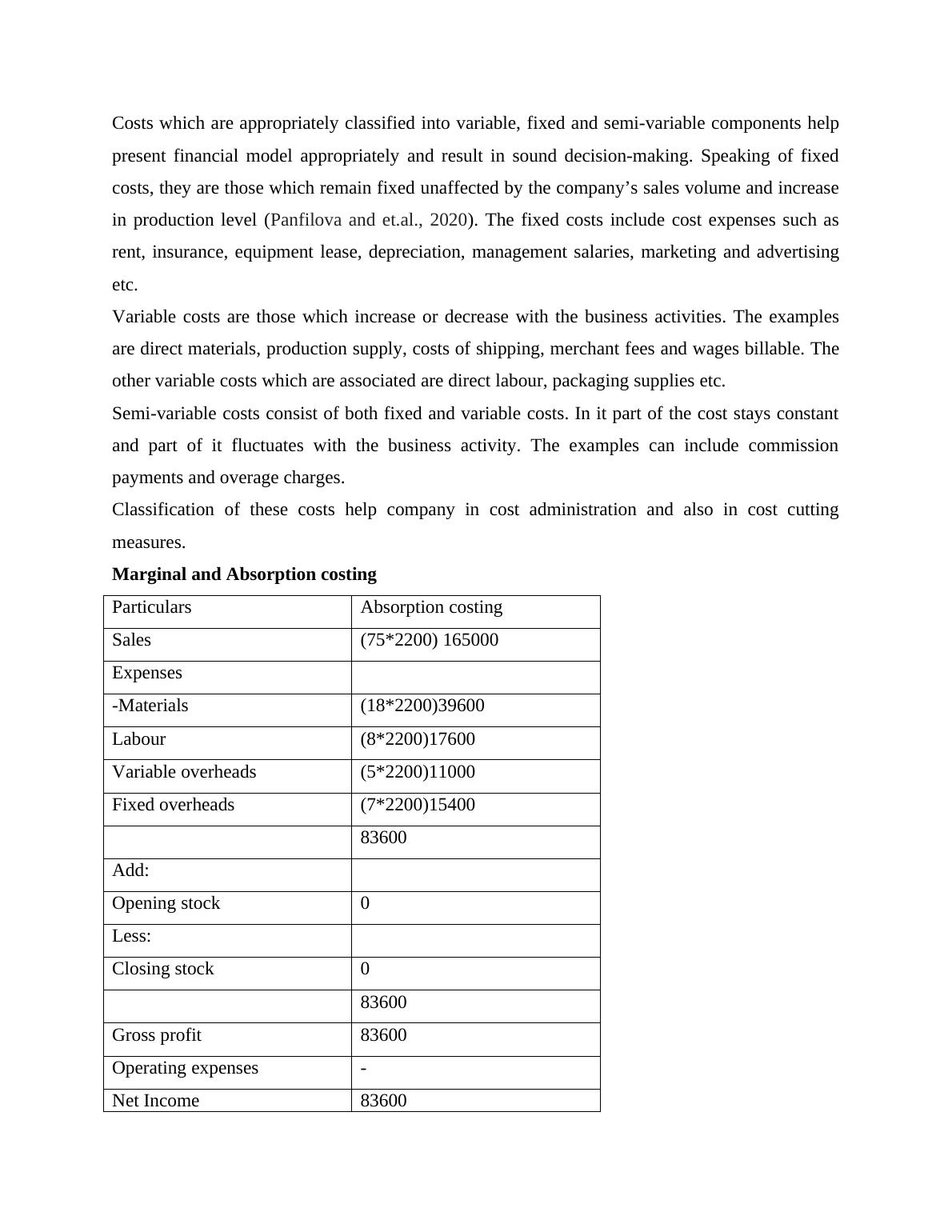Cost Management and Budgeting in Business Finance
Added on 2022-12-14
17 Pages2668 Words203 Views
BUSINESS FINANCE

TABLE OF CONTENTS
INTRODUCTION...........................................................................................................................3
Part A...............................................................................................................................................3
Part B...............................................................................................................................................6
CONCLUSION..............................................................................................................................11
REFERENCES..............................................................................................................................12
INTRODUCTION...........................................................................................................................3
Part A...............................................................................................................................................3
Part B...............................................................................................................................................6
CONCLUSION..............................................................................................................................11
REFERENCES..............................................................................................................................12

INTRODUCTION
The file is about cost management and budgeting. The analysis of different types of costs and
relevance to pricing decisions is illustrated. The absorption and marginal costing statements have
been demonstrated and reconciliation of profits has been done. The budget and its role in
controlling the business operations have been emphasised. The different types of budgetary
methods which help in controlling operations have been discussed.
Part A
Q1.) a) Contribution per unit=Sales per unit – Variable cost per unit=100-(45+30)/100=0.25.
Q2.) Break even point(units)= Fixed costs/(sales per unit-variable cost per unit)=125000/(100-
(45+30)=125000/25=5000.
Break even point (sales)= Fixed costs/contribution margin=125000/0.25=500000.
Q3.) Margin of Safety= Current sales level-Break even point/Current sales level=
(60000*100-500000)*100/60000*100=450000000/6000000=75%
Q4.) Let the break even units be taken as ‘x’.
Sales 100x
Less: Variable cost(45+30) 75x
Contribution 25x
Less: Fixed cost 125000
Expected profit 100000
By solving the equation,
25x-125000=100000
x=9000 units
Break even units required=9000 units.
Q5.) Importance of classifying a fixed cost, variable cost and Semi-variable costs and relevance
to pricing decisions
The file is about cost management and budgeting. The analysis of different types of costs and
relevance to pricing decisions is illustrated. The absorption and marginal costing statements have
been demonstrated and reconciliation of profits has been done. The budget and its role in
controlling the business operations have been emphasised. The different types of budgetary
methods which help in controlling operations have been discussed.
Part A
Q1.) a) Contribution per unit=Sales per unit – Variable cost per unit=100-(45+30)/100=0.25.
Q2.) Break even point(units)= Fixed costs/(sales per unit-variable cost per unit)=125000/(100-
(45+30)=125000/25=5000.
Break even point (sales)= Fixed costs/contribution margin=125000/0.25=500000.
Q3.) Margin of Safety= Current sales level-Break even point/Current sales level=
(60000*100-500000)*100/60000*100=450000000/6000000=75%
Q4.) Let the break even units be taken as ‘x’.
Sales 100x
Less: Variable cost(45+30) 75x
Contribution 25x
Less: Fixed cost 125000
Expected profit 100000
By solving the equation,
25x-125000=100000
x=9000 units
Break even units required=9000 units.
Q5.) Importance of classifying a fixed cost, variable cost and Semi-variable costs and relevance
to pricing decisions

Costs which are appropriately classified into variable, fixed and semi-variable components help
present financial model appropriately and result in sound decision-making. Speaking of fixed
costs, they are those which remain fixed unaffected by the company’s sales volume and increase
in production level (Panfilova and et.al., 2020). The fixed costs include cost expenses such as
rent, insurance, equipment lease, depreciation, management salaries, marketing and advertising
etc.
Variable costs are those which increase or decrease with the business activities. The examples
are direct materials, production supply, costs of shipping, merchant fees and wages billable. The
other variable costs which are associated are direct labour, packaging supplies etc.
Semi-variable costs consist of both fixed and variable costs. In it part of the cost stays constant
and part of it fluctuates with the business activity. The examples can include commission
payments and overage charges.
Classification of these costs help company in cost administration and also in cost cutting
measures.
Marginal and Absorption costing
Particulars Absorption costing
Sales (75*2200) 165000
Expenses
-Materials (18*2200)39600
Labour (8*2200)17600
Variable overheads (5*2200)11000
Fixed overheads (7*2200)15400
83600
Add:
Opening stock 0
Less:
Closing stock 0
83600
Gross profit 83600
Operating expenses -
Net Income 83600
present financial model appropriately and result in sound decision-making. Speaking of fixed
costs, they are those which remain fixed unaffected by the company’s sales volume and increase
in production level (Panfilova and et.al., 2020). The fixed costs include cost expenses such as
rent, insurance, equipment lease, depreciation, management salaries, marketing and advertising
etc.
Variable costs are those which increase or decrease with the business activities. The examples
are direct materials, production supply, costs of shipping, merchant fees and wages billable. The
other variable costs which are associated are direct labour, packaging supplies etc.
Semi-variable costs consist of both fixed and variable costs. In it part of the cost stays constant
and part of it fluctuates with the business activity. The examples can include commission
payments and overage charges.
Classification of these costs help company in cost administration and also in cost cutting
measures.
Marginal and Absorption costing
Particulars Absorption costing
Sales (75*2200) 165000
Expenses
-Materials (18*2200)39600
Labour (8*2200)17600
Variable overheads (5*2200)11000
Fixed overheads (7*2200)15400
83600
Add:
Opening stock 0
Less:
Closing stock 0
83600
Gross profit 83600
Operating expenses -
Net Income 83600

End of preview
Want to access all the pages? Upload your documents or become a member.
Related Documents
Management Accountinglg...
|13
|432
|59
Management Accounting Assignment - UCK furniturelg...
|12
|2724
|55
Management Accountinglg...
|10
|367
|55
Management Accounting Assignment : UCK Furniturelg...
|11
|2477
|168
Management Accounting Assignment: UCK Furniturelg...
|9
|2031
|262
Management Accounting: Marginal and Absorption Costing Techniqueslg...
|7
|838
|71
